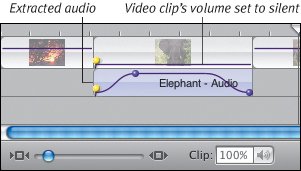| So far, I haven't mentioned the two obvious audio tracks that appear in the Timeline Viewer. These are typically where you would work with sound effects or imported audio files, but they're also the sandboxes for playing with audio that comes with your video footage. Before we can play, however, we need to extract the audio from the video clip. To extract audio: 1. | Select the clip in the video track. | 2. | Choose Extract Audio from the Advanced menu, or press Command-J. An audio clip, represented as a purple bar, appears in the audio track beneath the video clip (Figure 10.8). |
Figure 10.8. Extracted audio clips appear on the first audio track. The video clip's audio becomes silent.  Tips  | If you later delete an extracted audio clip, it's not gone forever. The original sound is still embedded in the video track, but its volume is turned down to zero so it does not interfere with the audio tracks. If you can't undo the deletion, select the clip and increase its volume to restore the sound. You can then extract the audio again, which places a new copy in the audio track. Extracting audio clips makes it possible to start playing audio before the visuals begin (or after they're done). For example, when editing the video of a recent camping trip, I wanted to portray how it felt to wake up one morning to rain (Figure 10.9). I opened on a few seconds of black frames with the sound of the rain pattering on a tarp, then faded in on the image of the wet tarp. The audio and visuals weren't synchronized, but that didn't matter because the clip was an establishing shot with background sounds.
Figure 10.9. Extracting the audio from the "Wet tarp" clip allowed me to begin playing the sound of the rain during a few seconds of black frames, then fade in on the visual of the tarp itself (top). You can view this clip at www.jeffcarlson.com/imovievqs/.  |
|


